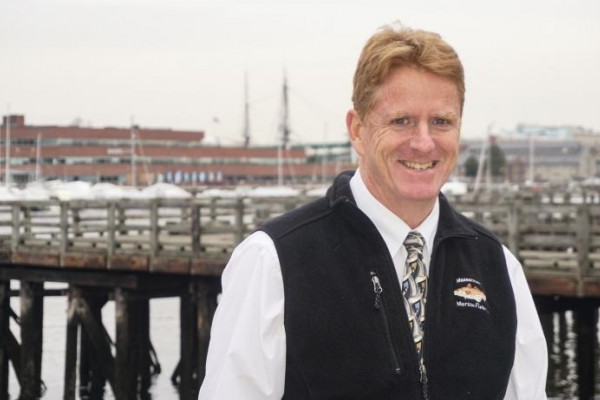
State Division of Marine Fisheries Director Dan McKiernan.
Doreen Leggett
Last year, when the pandemic sent fishery revenues crashing and had the industry on the rocks, Dan McKiernan, then acting director of the state Division of Marine Fisheries, got a call from John Pappalardo.
“We have a big problem and we have got to do something about it,” Pappalardo, the chief executive officer of the Cape Cod Commercial Fishermen’s Alliance, told McKiernan.
One of the things the state did right away was issue free retail permits, launching a dockside sales movement that caught on better than most imagined.
“I think John was real helpful in seeing the problems on the waterfront,” said McKiernan, who has since become director of DMF.
McKiernan told that story to a group of industry and community members gathered, via Zoom, for the annual meeting of the Fishermen’s Alliance February 3.
With almost a full year of the pandemic in the rearview mirror, McKiernan shared some impacts. Many fishermen saw their revenues cut by 25 to 35 percent. Some were hurt less, but oystering was cut in half. These losses are significant; a 22-percent loss in direct lobster and crab revenues to fishermen translates into close to $20 million. Total losses across all species was $121 million.
The pain was mitigated somewhat by $300 million for fisheries in the federal COVID relief bill. Massachusetts received the largest amount on the East Coast, $28 million, and funds were distributed last year. Pappalardo was on the state advisory board that helped devise a structure to disperse the funds, McKiernan said.
“We were the first state to get all the money out on the street,” he added.
McKiernan said another round of funding is on the way, although he expects Massachusetts fishermen will get a little less this time around.
As hopes for a more economically stable year in 2021 grow, McKiernan spoke of another serious issue on the horizon.
He said that people often throw around the term “existential threat,” but when it comes to the intersection of endangered right whales with the pot and gillnet fisheries, it may be apt.
McKiernan said the state has gotten out ahead, facing the specter of a court date in June. New regulations have been adopted, including a commercial trap gear closure from Feb. 1 to May 1 and mandating lines which break at 1,700 pounds (science has shown this sharply reduces whale entanglements). The new rules are designed to meet required protections for whales and keep small businesses on the water.
“We are doing everything we can to keep the fisheries relatively intact,” McKiernan said.
The lobster industry, perhaps most impacted, has more than 800 active permit holders. All of them are owner operated, not corporate owned, McKiernan said.
The state has also received a $200,000 grant from National Fish and Wildlife Foundation to look at how, among other things, ropeless technology might fit into the larger fisheries management scheme.
A number of groups are testing ropeless gear, removing buoys and vertical lines that stretch to the surface. Lobstermen steam to where they set their traps and then send an acoustic signal down to gear on the ocean floor. Lines pop up and are retrieved right away.
McKiernan said that ropeless would be costly to implement, probably around $75 million, and there are safety risks and potential conflicts with competing fishermen not knowing where traps are located, encountering and destroying gear. Most people expect that it would take years to address and possibly resolve these issues.
McKiernan and his staff, along with the Fishermen’s Alliance and UMass Boston’s Urban Harbors Institute, are also completing a Massachusetts Port Profiles Study.
The report includes details on every port in the Commonwealth: what species are landed, amount and value, resources each port offers, major needs and challenges. People can see the top 10 ranking ports; Chatham, Barnstable, Provincetown, Wellfleet and Sandwich are third, fifth, seventh, eighth and tenth respectively.
Specific details are also included. For instance, Chatham has close to 200 permitted harvesters with about 300 vessels calling Chatham their homeport. Surveys completed by industry members offered insights into needs, assets, and shortcomings; again using Chatham as an example, fishermen can get ice but there is no bait storage.
The port profile study, soon to be released, also makes some broad infrastructure recommendations such as ideas for new sources of funding for dredging; reassessing commercial and recreational mooring needs; improving existing dockage and shoreside infrastructure; dedicated parking for commercial and for hire fishing businesses; and improved access to boat ramps.
As a final bit of business at the annual meeting, members elected Andy Baler and Kurt Martin as new members of the board of directors and said thank you to Nick Muto, who stepped off after three terms.
